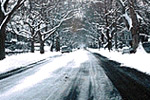TREE TALK
Originally published in Capital on 9/9/2006.

When is my tree going to fall?
Tips on Shade Tree Maintenance
One of the most common questions I get from people is “When is my tree going to fall?” It’s a good question too. And one without any simple answers. Any standing tree has the potential to cause serious injury or death if it should fall on a person. A relatively small 6-inch diameter tree, 30 feet tall will weigh close to a ton. In fact, one of the most common causes of death on forest fires occurs when trees fall on an unsuspecting firefighter because a deep-seated ground fire undermines their root system. They are dangerous, and a hardhat is little help except to mark the spot where they found you.
One of the universal truths is every tree will fail over a life span. Whether it falls because it was cut down or the wind blows it over, eventually it’s going to be lying on the ground. If the tree is growing off by itself, then no problem. If it falls it won’t hurt anything. If a tree has a target though, then it’s a different story for damage or injury can happen. If a large tree is right next to your home it’s kind of hard to move the house out of the way of the tree, most houses being difficult to move. The tree’s going to fall eventually but you want to keep it there as long as possible, since it’s providing shade and bunch of other benefits that would be sorely missed. What can be done is to make sure the tree stays healthy for as long a possible. This means seeing to its needs. Things such as fertilizer can help, especially if the soil is poor. A simple soil test can let you know if it’s needed. During dry spells, watering will help the tree through to the next rain.
What else can be done? For one thing, if the tree is near the driveway or a road, STAY OFF THE ROOT SYTEM WITH YOUR CAR! Didn’t mean to shout but it needs to be emphasized. Whereas the leaves on a tree make the food, the roots do the rest of the work. The roots take up the water, minerals and other nutrients the tree needs to sustain life. Parking a car or cars underneath the tree will over time compact the soil so water and oxygen can’t penetrate the soil.
Another good idea that can relieve or prevent headaches as the case may be, is to trim dead branches off the tree so it can heal over where the branch was so decay doesn’t enter the main stem. If you are pruning make sure the pruning cut doesn’t injure the branch collar, if in doubt or especially if the branch is large and hard to reach, call a Tree Expert. They are trained and equipped to prune the branches safely. Don’t put your life in danger just to save a few dollars. And if the tree does need to be taken down they are the ones to call to have it done safely.
Checking the tree at least once a year for signs of cracks in the branches or the main stem is another good idea. If a crack extends deep into the tree where it reaches the heartwood, then it’s a serious issue as decay can start and go right to the center. Large deep crack also indicate the tree isn’t able to support the weight of the braches or crown of the tree, indicating it could come down any time. Trees such as silver and red maple are prone to this type of injury, but can occur in any tree. One type of crack that commonly shows up in trees is the frost crack. This happens to mostly thin barked species such as maples where the winter sun warms the wood under the bark and the water in it’s tissues, then the sun goes down at night, it gets cold and freezes, and it cracks. This generally only involves the sapwood so it’s usually just a surface defect as the sapwood can fend off decay organisms usually. Next article we’ll talk about tree diseases.
Questions and comments can be directed to forestgreenway@comcast.net
Bud Reaves writes Tree Talk for the Anne Arundel County Forest Conservancy District board.
Additional Forestry-Related Links
Champion Trees of Anne Arundel County
Big Tree Champions of Maryland
Native Plants for Anne Arundel County
Planting and Care of Your Trees
TREE-MENDOUS MARYLAND
Invasive Species